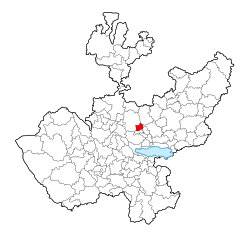Guadalajara
Guadalajara | |
|---|---|
| Ciudad de Guadalajara City of Guadalajara | |
|
| |
| Nickname(s): | |
| Motto(s): Spanish: Somos más por Guadalajara, (English: We are more for Guadalajara) | |
 Location of Guadalajara within Jalisco | |
| Coordinates: 20°40′36″N 103°20′51″W / 20.67667°N 103.34750°W | |
| Country | |
| State | Jalisco |
| Region | Centro |
| Municipality | Guadalajara |
| Foundation | February 14, 1542 |
| Founded by | Cristóbal de Oñate |
| Government | |
| • Mayor | Ramiro Hernández García (PRI) |
| Area | |
| • City | 151 km2 (58 sq mi) |
| • Metro | 2,734 km2 (1,056 sq mi) |
| Elevation | 1,566 m (5,138 ft) |
| Population (2010) | |
| • City | 1,495,189 |
| • Density | 10,361/km2 (26,830/sq mi) |
| • Metro | 4,424,252 |
| • Metro density | 1,583/km2 (4,100/sq mi) |
| • Demonym | Tapatío guadalajarense |
| Time zone | UTC−6 (CST) |
| • Summer (DST) | UTC−5 (CDT) |
| Website | www |
Guadalajara is a city in Mexico. Over three and a half million people live there. It is the second-largest city in Mexico. It is the capital of the Mexican state of Jalisco. It is in Western Mexico and is over 5,000 feet (1,500 m) above sea level. Guadalajara is a major Latin American city in terms of industry, tourism, and culture. A famous soccer team called Chivas Guadalajara plays there. In 2011 Guadalajara hosted the Panamerican Games and Plans to bid for the 2028 Summer Olympic Games. In 2005 Guadalajara was called the City of Culture 2005. Guadalajara is home to a largely celebrated culture of "New Modern Mexico". Guadalajara is also known for Mariachi (a form of folk music) and Baile Folklórico, traditional Mexican dances.
The city is named after Guadalajara, Spain.



